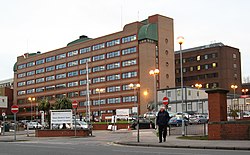| Royal Gwent Hospital | |
|---|---|
| Aneurin Bevan University Health Board | |
 Cardiff Road entrance of the hospital | |
| Geography | |
| Location | Cardiff Road, Newport, Wales, United Kingdom |
| Coordinates | 51°34′48″N2°59′53″W / 51.580°N 2.998°W |
| Organisation | |
| Care system | NHS Wales |
| Type | General |
| Services | |
| Emergency department | Minor Injury Unit only - not a full Emergency Department |
| History | |
| Opened | 1836, moved 1901 |
| Links | |
| Website | abuhb |
The Royal Gwent Hospital (Welsh : Ysbyty Brenhinol Gwent) is a local general hospital in the city of Newport. It is managed by the Aneurin Bevan University Health Board. Since 2020, the hospital no longer has a full Emergency Department, and redirects those with a serious illness or injury to call 999 or go to attend the Grange University Hospital in Cwmbran. The Royal Gwent hospital has a 24-hour Minor Injuries Unit.


